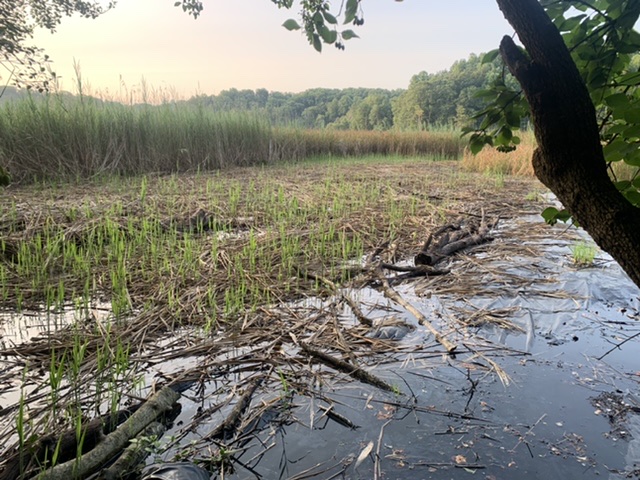By Grace Mayer, ’22/’23 Chesapeake Conservation Corps Member
Phragmites australis is a common invasive reed that is all-too-familiar to many environmentalists in Maryland. Phragmites was introduced to the region in the 19th century from Europe and Asia by ship and grows in brackish and fresh water. Patches of phragmites can be seen along Parkers Creek, where they provide few benefits to local wildlife and crowd out native vegetation. There have been many efforts to slow the spread of the invasive reed in the Chesapeake Bay watershed, and one of the more common methods used to control phragmites is through the use of a glyphosate herbicide.

Phragmites spreads quickly through seed dispersal, rhizome and stolon growth, and through rhizome fragments. Stolon (above-ground runners from existing phragmites) and rhizomes (under-ground stems spreading from the roots) can both sprout new plants, meaning that phragmites spreads even if it doesn’t go to seed. Cut fragments of plants can sometimes re-establish after relocation, making it possible for phragmites to spread to new areas on equipment used for control.
Because of the ease and number of ways in which phragmites can spread, single control methods like cutting or mowing tend to be ineffective. Even if the plants are made unable to produce or spread seeds, the underground and aboveground offshoots can continue to generate new plants.

ACLT has been taking steps to slow the spread of phragmites in the marsh surrounding Parkers Creek for the last several years. Rather than utilizing herbicide which can be expensive and carry certain environmental risks, ACLT has been using a mechanical method of control. ACLT staff and volunteers cut the phragmites at water level using weed whackers and then covered the cut areas with black plastic. The plastic serves to overheat the rhizomes under the water and block sunlight from reaching the plants after the stem has been cut. The plastic is generally left on for about one year, although in some cases it is left on for a second growing season if the phragmites persists under the plastic.
ACLT has had success with this method in several areas and the level of phragmites control after just one year has been impressive. Additionally, the number of native plants that naturally repopulate the site during the first growing season after the plastic has been removed has been higher than we anticipated. Patches of phragmites, as well as sites previously covered in plastic, are scattered along Parkers Creek and some can be seen from the Parkers Creek Loop trail and on ACLT’s canoe trips.